
Preventing and treating injuries from falls!
falls are one of the most common causes of injuries in little ones. Learn how to prevent falls from occurring in the home and what to do when a baby or toddler sustains an injury from a fall.

It’s not uncommon… you go to the beach and someone in the family ends up with irritated skin. When you are exposed to the elements, there is a list of potential causes of skin irritation. Sunscreen reaction? Sand? ‘Swimmer’s Itch’? Many people put it down to ‘Sea lice’ – and in their head, envision tiny creatures that live on jellyfish until they find a human to annoy!
The truth is, sea lice aren’t actually a specific creature. Australian Marine Stinger Advisory Services director Lisa Gershwin explains;
“‘Lice’ is a general term for anything that causes skin irritation, itching, or pain in the ocean. Sometimes it’s little crustaceans that might give us a little itchy, niggly feeling. Other times it might be fragments of jellyfish tentacles or even little tiny species of jellyfish.”

So there you have it! ‘Sea Lice’ covers an array of potential skin irritants found in the ocean. The most important thing – if it causes distress or the condition worsens, it is always best to seek medical attention.
For further reading, visit ABC’s story ‘Sea lice: What are the tiny ocean irritants?’

falls are one of the most common causes of injuries in little ones. Learn how to prevent falls from occurring in the home and what to do when a baby or toddler sustains an injury from a fall.

CPR Kids + Kiddipedia = It’s a match!

The ACCC recently created a new mandatory standard for children’s toys (up to and including 36 months). We have summarised the key points you need to know!